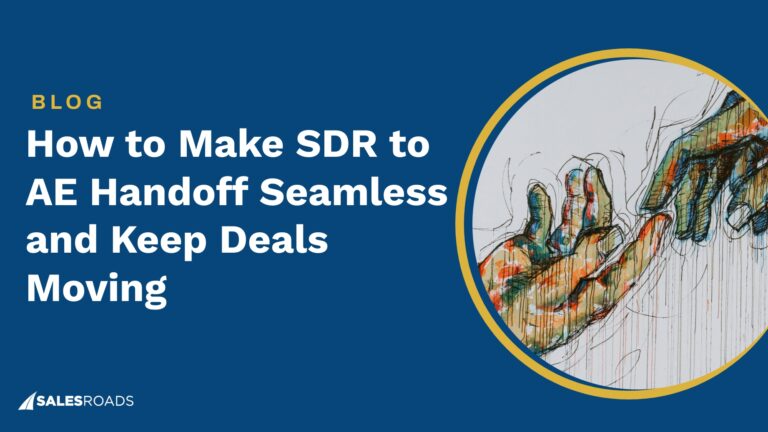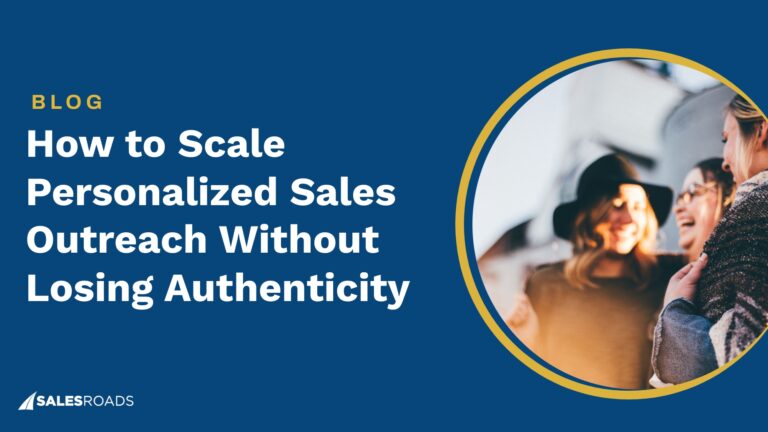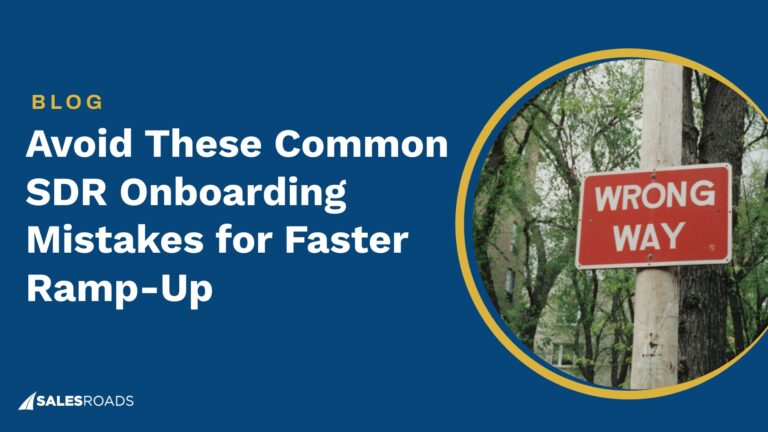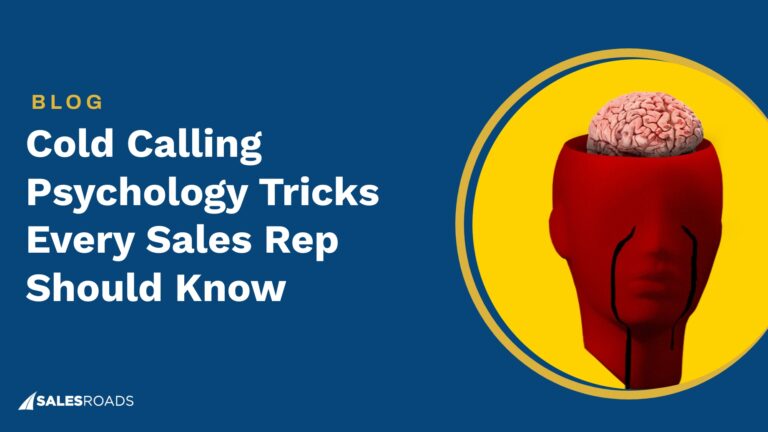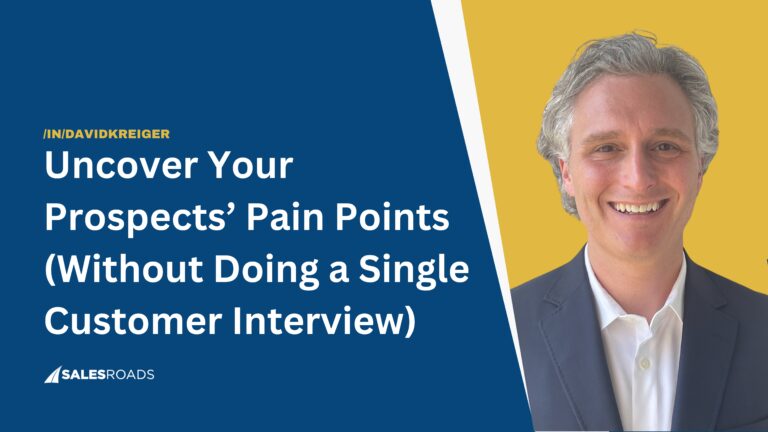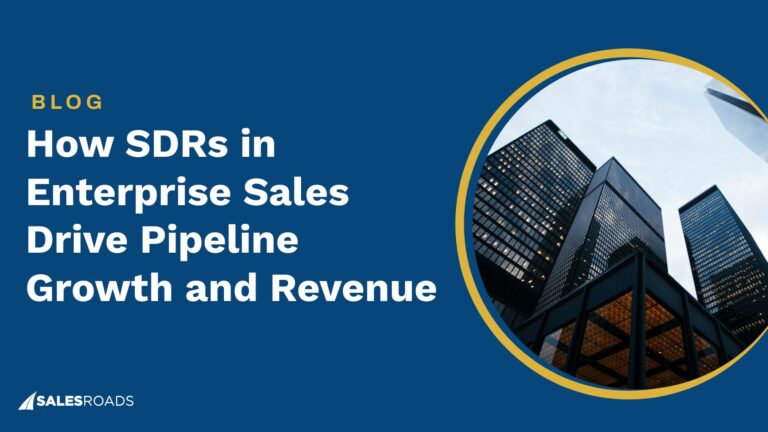Sell Like A Leader – Episode 4
In this episode, we dive into:
– Rock-solid processes for sales leaders: why sales leaders under pressure to achieve more with limited resources need a structured and organized approach to sales.
– Rules of engagement in sales: the concept of ROEs, their role in aligning sales teams, avoiding internal conflict, and improving prospect and customer experience, and the consequences of not having clear ROEs.
– Pitfalls and best practices for implementation: steps to identify the most pressing issues to solve for, how to secure buy-in across the entire executive team, and how to deal with resistance from top sellers.
– Post-implementation challenges: managing adherence, handling exceptions and deviations, and the importance of continued focus on processes and efficiency.
– Rapid Fire Q&A
About Joe Venuti
In episode #4, David Kreiger chats with Joe Venuti, the VP of Sales at Global Market Innovators. This is the 4th company he’s held a VP title at. Joe has a strong background building and scaling high performing sales and sales dev team at companies like Cube Software, UpKeep, and Sendoso.
Podcast Key Takeaways
- Sales leaders need solid processes to navigate the challenges of doing more with less in today’s economy. Being agile and focusing on areas with the most traction is key.
- Implementing ROEs is essential as sales teams grow and change. Letting a few initial collisions happen helps tailor the rules to solve specific challenges.
- Getting buy-in from the whole team and involving impacted individuals in the rollout is vital. Once in action, sticking to the ROEs is the name of the game.
Connects
Connect with Joe Venuti: https://www.linkedin.com/in/joe-venuti-04b34b49/
Connect with David Kreiger: https://www.linkedin.com/in/davidkreiger
Subscribe to the podcast and follow our Podcast LinkedIn page so you don’t miss any episodes!
Transcript
David: Hello and welcome back to the Sell Like a Leader podcast, the podcast for revenue leaders who are on a mission to cultivate a high-performing sales team within their organization. I'm your host, David Kreiger, founder of SalesRoads, America's most trusted sales outsourcing and appointment setting firm.
Today, we bring you another fantastic sales leader, Joe Venuti. Joe is currently VP of Sales at Global Market Innovators, and this is the fourth company that he's held the VP title at. So he is bringing a wealth of experience from a lot of different avenues and a lot of different situations, and he just has an amazing background building, scaling high-performing sales teams, like Cube Software, UpKeep, and Sendo.
Welcome to the show, Joe. Let's get started. Thanks for being here.
Joe: Thanks a lot, David. Excited to be here. I appreciate the invite.
David: Yeah, I'm excited and I'm excited about the [00:01:00] topic today because I think it's really important and not a lot of folks really dive into it. And so I'm excited to hear your perspective. And where I wanted to start, though, Joe is, I think, a lot of companies, technology companies, just around the country and around the world, have seen rising interest rates.
And, that's put a lot of pressure on sales leaders by higher-ups, by investors to do more with less, with capital being much more expensive than it was just a few years ago.
And so I'm just curious, how would you advise sales leaders to be able to respond and be able to do more with less?
Joe: Yeah, I think that we were riding an all-time high the last few years. And then, the last 18 months or so, we've seen a huge dip. And it's evident by every time you're on LinkedIn, there's another layoff. In fact, not even five minutes ago, I got a text from a former employee, still friend.
She was laid off this afternoon. We're in a world that like we haven't experienced in a long time. And to your point, like investor money and VC [00:02:00] money is drying up or at least it's harder to get your hands on than ever.
So it leaves the sales leader to really have to fall back on the incumbent team or even the team that has been scaled back to often produce the same, if not more than you were when you had 20, 30, 40 percent more heads.
At the end of the day, the only way to combat that, the only way you're going to have a fighting chance, is with rock solid process. Everyone's sales process looks different.
Everyone's prospecting processes look a little bit different. As a sales leader, you've really got to roll up your sleeves, get in there with the team, and understand where you're seeing the most velocity and the least friction and how to double and triple down in that area.
And then in other areas, don't be afraid to fail fast. And then be really agile and pivot away. There's no room for ego now. There's a lot of room for experimentation, but you've got to be really honest with yourself. The results are not there, and they're not there quickly. It's probably a failed experiment.
That's okay. You learned something. Move on to the next. At the same time, these experiments that did work double and [00:03:00] triple down. Strike while the iron's hot.
David: And one of the things that, you know, as we were prepping for the show, you've spoken about a process that you've implemented and maybe you can talk a little bit about where you've implemented it, when you started doing it, but can help sales leaders really figure out what are good processes and then memorialize them, and that's rules of engagement, right? ROEs.
And so, can you maybe introduce that concept of the ROE to the audience and talk a little bit about why you think they're so important?
Joe: Yeah, sure. So the set of laws in which the sales team is going to abide by. Over the last several years and the companies that you've listed, I've gone into very early-stage companies. GMI is probably the most mature company that I've started with in quite some time.
And a lot of times, rules of engagement don't exist because you're coming into a sales team of three or four or five, and that's okay, right? They can all just get along, and the database is big enough, and they'll share this, they'll share that. But all of a sudden, you bring in a head of sales, and then, typically, I'll come [00:04:00] in and we'll try to build some process.
We'll try to cut up the books of business, and however you choose, right? Geographically based, verticalized, it doesn't matter, but you try to make some sense of it all. And then before you know it, your team of four just grew to eight, and then your eight is 12, and now you have two managers in the mix.
And then if things are still going well, all of a sudden there's four managers and a director, and now there's 25 or 30 sellers.
And I think the biggest question is, when do we crack down and stop being the wild west and really start to drive some synergy across what the sales teams are doing?
When I came into GMI, there was a loose set of ROEs. And again, like the sales team that I came in and took over was not large, but we're scaling quickly and what I chose to do, and this is probably what I think is the best practice, is to sit back and let some of the collisions happen, so I understand what I'm solving for.
Every company's challenge is unique. Every company goes to market a little bit differently. Every company defines Enterprise, FED and SLED a little bit differently. So [00:05:00] I like to sit back and just let some of the collisions happen so that I understand the main things I need to solve for.
And then basically, I'll move forward from there and iterate. It's quite a long process to go from the seat that I'm in now, two and a half months into this role, to being able to walk in my CEO's office and say, Here's the ROEs, read through them and bless them, come and roll them onto a sales team.
It's not just something I can whip up overnight. There's the table stakes thing. So there's the things that are going to be in every ROE. We define enterprise as 2,500 employees in a file. We define SMB as under a hundred. That stuff's all easy, and it's table stakes. It's like the parent and sub relationships, right?
That's one of the biggest pain points.
David: Why that is so important? What happens when you don't have those clear ROEs? And then how does that open up and make people more productive once you put those in place?
Joe: I think that the two things that scare me the most about not having a clear ROE [00:06:00] and not having sales reps understand where they do and don't belong is, first and foremost, the prospect and our customer experience. There is nothing worse than inbounding to an organization, right? Think about it.
We just talked about how the economy is tough and revenue is difficult. Here I am with a check in hand because I know I want to buy what you're selling. So I go to your website, I fill out the form. Next thing I know, Rep A reaches out. Hey, I'll be your point of contact. Let's set up a call for Tuesday. Forty-five minutes later, Rep B reaches out.
Same message. The one that worries me the most is, did I just cost myself an opportunity with someone that had a blank check and was ready to buy? I didn't have to sell to that person. And now I've already turned them off. Second of all is the culture around my sales floor.
Any sales leader wants to build a culture of reps that are pulling in the same direction, helping each other out, celebrating each other's wins, where like nobody wants to live and breathe on that shocky sales floor where your leads are getting stolen. Like it doesn't exist as much as [00:07:00] it used to exist, because there are tools to prevent it.
But if you don't have clear rules of engagement—This is your book of business because of X, Y, and Z. It doesn't matter what that X, Y, and Z is, right? It's different for every business. Maybe it's geo-based, maybe it's verticalized, or maybe it's just account-based, and these are the 500 accounts that we're giving you to go and penetrate and manage and sell to.
But if there's none of that, it's a free-for-all. The famous question that I get, cause again, a lot of the companies I've walked into, is, There's no ROEs—the famous first question I get, and usually my first or second team meeting is how long before I could take an account outta somebody's name if they haven't touched it?
Is it a week? Is it three weeks? I don't think that's a scalable process, right? Because if I'm a sales rep and I reached out to you, we had a conversation and you said to me, today, on, on the 13th, call me back in July and I have a note on my calendar to call you back in July.
Another sales rep comes in and says, Oh, Joe hasn't prospected this account in 90 days. I've taken it. Joe's really [00:08:00] mad because there's a reason why I didn't prospect, right? So then you can just see the snowball effect that starts, right? And then that's one example, but now you grow this team to 20 or 30 or 50 or 70.
It's nonstop all day. So those are the two biggest things that I want to mitigate: poor experience for my customers and my clients.
And I want synergy on my sales floor. So it is a culture of cheering each other on, being one team, driving to a common goal, not counting down the last three days before I can swipe this lead from somebody.
David: I love how you start with buyer experience because I think a lot of people think of this more in the second bucket, which is really important, but you don't think about how it impacts not just your internal team, but it actually impacts your prospects. And you spoke to the folks who are low-hanging fruit, but those ones that you have to work and really make sure that you're explaining the value, understanding their problems.
If you have reps stepping all over each other and you have another competitor that's got a seamless process, who's going to win that deal?
And then [00:09:00] lastly, one thing that I think is baked into that and you alluded to it really well, our job as sales leaders is to help our team be more efficient.
And what is less efficient than spending what could be sales time on just fighting over leads, walking to your sales leader's office, talking through it. You could be working on processes, they could be working with a prospect. And so it just really has so many different ramifications on a sales floor. So that's great. Now you've talked about some of the companies that you walked into, or you've seen that, that didn't really have ROEs. Have you seen some, or even for yourself, right?
Because, as you said, it's sometimes it takes a little bit of walking into each other and mistakes, where have you seen some pitfalls of ROEs, or ROEs may be implemented incorrectly?
What did that look like? And what are some of those fixes?
Joe: The thing with ROEs, and it's probably gonna sound like I'm talking out of both sides of my mouth and maybe I am, it's just a business need, right? You want to write your ROEs and you want to stick to them, right? They want to be set in stone. [00:10:00] This is what we're doing.
But after a period of time, maybe it's a quarter, maybe it's two quarters, maybe it's a year, the business needs change, and the ROEs may need to change with them.
But as a sales leader, every time I rewrite or make a major change to my rules of engagement, I understand I'm moving the goalpost on my sales team. And I want to do that as few times as possible with things like ROEs and comp plans.
Like that's the stuff that you want to set in stone, and you want it to work.
So one of the biggest lessons I've learned this is actually at Sendoso. Again, I went in very early, right around the A round, I think I was the 16th person they hired. By the time I left, I had a team of 75. I was there for just over three years, but our first VP person that hired me, him and I were working on the first set of ROEs that Sendoso was ever going to have.
And it was the first time I'd gone through this exercise. So I was like, all right, like pen to paper, this should work that way, this should work that way. And he slowed me down and said, just wait, give it three weeks. Just [00:11:00] keep track of all the collisions. And I alluded to that with your previous question.
I think it's really important to let some of the collisions happen. I know it's painful. I know you have to manage the team through it, but the things that I was thinking about is just the things that were top of mind for me in that moment.
As I sat back and did what he said, the things I actually had to solve for were very different from what I just assumed was going to be the issue. I can't go and take what I wrote at Sendoso and just dump it here at GMI, right? We ended up with, at Sendoso worked really well, but it's a different sales cycle. It's a different team. It's a different target audience. Everything's different.
There's just very few similarities, other than the fact we're trying to drive revenue. So the ROEs are really never plug-and-play company to company. But I think that the exercise of understanding the biggest things you need to solve for first, right? If you can chop off the four or five biggest problems, you then the rest almost just becomes details.
And that's the way that I've approached it, but to [00:12:00] answer your question, ROEs that are not written to solve the specific problems on the floor become nothing more than just a document. And if it doesn't benefit anybody, it's not going to change any behaviors in a positive manner.
When you do roll them out, like you have to know that, every company has those couple of account executives that have been there from day one and they have the lion's share of the accounts.
And when this ROE day comes, like their book of business is probably getting cut. So you have to understand there's going to be things in there that people love you for.
There's going to be things in there that people don't love you for. But helping get the team through the change management and understanding the bigger picture and why, hey first account executive in, you have all of these clients you're already managing.
If you close another 50 deals, you can't manage all those clients and draw up a new business, right? So let them see the bigger picture that you're actually protecting them. So there's a lot of explanation and a lot of giving them the why, as you're going through the rollout of ROEs too, so that they're bought into them.
[00:13:00] Cause if they're not, you're just forever pulling things out of their name, talking to them about why. So, like the rollout is really important too.
David: Folks who are listening could benefit from some specific advice around that. Because I, I think that sometimes sales leaders, especially ones who are coming in, or they've been there for a while, they don't implement ROEs to try to avoid exactly what you said.
They don't want to piss off that, the top seller, right? They don't want to go through that change management because it's tough. Especially for your top producers, because like you said, a lot of times they have the lion's shares of the deals. And or our accounts.
So can you talk a little bit about that through the battle scars that you've had through leading four organizations and how, after you've allowed some of those collisions to take place, and you've got a vision for what you think a framework of those ROEs should be, what advice would you give to sales leaders?
To be able to implement that in a way that is going to minimize [00:14:00] disruption and maximize them embracing this new process.
Joe: I think that the biggest thing, and this is probably sounds very common sense, but I've had a lot of sales leaders. Don't think of it the first time they've taken a crack at this. I know that I didn't make sure you have 100 percent buy in across the board for the rest of the executive team, right?
Cause the tenured rep that's been there a year or two years longer than you, whether you like it or not, has a direct line to your CEO or your co-founders. And if those people don't understand why you did what you did or what you rolled out and not bought into them, you're going to find yourself really between a rock and a hard place.
So step one is make sure you have absolute buy-in across the board with the entire executive team. Second of all, the people that I feel are going to be most heavily impacted, it's almost becomes a negotiation. I'll talk to them, right? I don't just roll this stuff out of left field. Like I'll let them know in one-on-ones, hey, ROEs are coming here.
Some of the things we're thinking about. And when you do have that rep that is fired away your bestseller [00:15:00] and has fired away 10 times more accounts than anybody else. Basically, what I try to do is create a timeline with them, right? It doesn't need to be, hey, I'm going to talk to you on April 1st about ROEs.
And boom, that's it. I'm ripping a thousand accounts away. It's hey, listen, like, why don't you identify the 50 that you have something going with? Those will be the exception to this ROE because you're a legacy person. You've done so much work there. So you can meet them in the middle, right?
It doesn't have to just be like a rip and replace. Bringing them into that conversation is really important. They feel valuable to the organization. They certainly feel, if you just come in and do this, pull all this stuff away, it really makes for a tough road with you managing them going forward.
Whereas if you bring them in and counsel them and explain the why and give them a little bit of leeway to hold on to the most important things, or just give them 90 days or six months to close certain things, make some concessions for them. They will appreciate it. They'll feel much more needed and wanted by the organization than if you just pull the rug out from under them.
I think that like those are the two biggest pieces of advice I can give you when it comes to [00:16:00] rolling out a new set of ROEs. Executive buy-in and make sure that the team is informed. They should, the first time ROEs get rolled out, the first time they hear ROEs are coming, should not be when you pull the team meeting together and go through page by page.
The last thing I'll touch on, and this is something I learned the hard way, but I'm really good at it now, is you probably want like an unbiased party being the person that's enforcing these, right? I always like to default to my head of sales ops, right? Whoever your head of sales ops is. That should probably be the person.
That's looking at it and saying, okay, this is the way this should go based on the ROE. If you have two directors or two frontline sales managers fighting over a deal, that's never a good situation. Then you as the direct manager, it's almost like I got to, who's my favorite kid, right? And so I think that you need to push that burden out of the direct line of sales.
My personal opinion is like your head of sales ops should probably be the person that's playing arbitrator on a lot of these. You just have to empower them as a VP of sales or as a CRO. They [00:17:00] understand these. They probably helped you write them because of that.
That's their expertise, but they're also going to be judged during execution or when problems do arise because I don't care how good your ROEs are, someone will do something that will find a gray area that you never thought of.
David: I don't think it's necessarily common sense. ’Cause I think sometimes heads of sales don't think that their executive team wants to be burdened with some of these types of details. But I think, like you said, it's really important to get that buy-in and then have those side conversations.
It's so much different when somebody feels at least somewhat involved in the process. And so if you can get the folks that you know are going to be impacted as much as possible, you can't do exactly what they're probably recommending you do, but at least if you can come through the process, present it, talk to them about how this is going to impact them, get their feedback, and then tell them what things you can incorporate and what you can't.
I think when people feel involved, they feel empowered, and you can tie it to the greater good of the company and the sales team, and also find ways to try to tie it to them as well. So the last [00:18:00] part is you've rolled them out hopefully it's gone as well as possible, right?
But people now have to abide by the ROEs. And so are there any best practices or things you've seen as people, after people have made the switch? Are people still running into each other at the beginning? How are you training them? How are you coaching along those lines? Or do you feel like if you've structured it the right way, rolled it out the right way, that's really where the heavy lifting is.
Joe: There's two phases of the rollout, right? The first phase I just alluded to, and that is like that period of time where there's still holdover accounts, right?
If I just—an example would be if I just moved the bar and said enterprise used to be from a thousand employees up, but now it's going to be from 1500 employees up.
So all those accounts that are between 1001 and 1500 are going to be coming out of enterprise, going to mid-market. But you've got to give some sort of a grace period, right? So maybe it's going to be a slow drip over the next three months.
So you've got to get through that period and hold people accountable to releasing accounts as you're supposed [00:19:00] to, and then once the dust settles on all of those, now it's time to sit back and no matter what happens, you as the sales leader, you as the sales ops person that's enforcing this, every single decision you make around opportunity credit, account distribution, pipeline attribution is another whole conversation that plays into this ROA, but it has to be to the letter of the document that you just rolled out.
The second, the one time you make an exception or deviate from it, no matter how bad you feel for that one rep that has a valid case—the first time you deviate from it, like you've thrown all of those months of work out the window and it's really difficult sometimes, right?
Because you've got the rep that's the hard worker and is maybe struggling a little bit and has this big deal, but the ROE says something else, right?
I think the best example is you give them 90 days to close whatever, and the prospect signs on the 94th day. It's not theirs anymore, and it stinks. And as [00:20:00] a human, you want to do anything to give it to them. But if you make that one exception, you've just discredited all the ROEs that you just rolled out.
David: That is tough. Because you don't want to feel like you're demotivating that individual, but those are the critical conversations you've got to have as a sales leader.
And so just to wrap up this portion, and then I want to move to our rapid fire questions, from what you've seen, either at the organizations that you've been leading the past few years, or just from your peers or people that you network with, there's been a lot that people have to juggle.
Have you seen ROEs taking on more critical importance? Is it the same? How do we stand here in 2024 with ROEs versus over the past few years?
Joe: I think if you're talking about like massive organizations, this probably hasn't been a big change because they're so flushed out. There's thousands of employees that have to abide by them. I think when you look in the startup world—this is the SaaS startup world, which is where I came from—this grow-at-all-costs mentality, in some ways, had, in my opinion, like a lot of sales leaders just throw caution to the wind and said, forget it.
I'm not going to worry about the rules. [00:21:00] We're just going to go grow at all costs. And I think a big part of that has been hire more, and we're going to get more revenue with more heads, but the human capital outweighs the revenue that we're bringing in. And then it gets us right back to where we were just at the beginning of this conversation.
All that extra human capital didn't drive enough revenue because you didn't have the right rule sets in place. You didn't have the right processes in place.
So now you're cutting back all that extra capital, plus probably some of the original. And now you've got someone like me sitting at a desk saying that old diary that I used to have, it's probably time to dust that off and get the team back on track.
David: So it does really, at the end of the day, going back to the beginning, and to the efficiency, and focusing on making sure that an organization can do more with less. It's not necessarily one of the first things that a lot of people think about, but if you see how that just can be the backbone in making sure that the culture is right, that you're treating the buyer in the right way, that you're making sure people are efficient with their time.
Sales leaders who are being tasked with trimming [00:22:00] down their team while still hitting at least the same quota, or maybe higher quota—this is one of the things really to focus on. So thanks for spelling that out, Joe, that's really helpful for me. And I think our listeners as well.
So what we like to do at the end is to just have a few rapid-fire questions. You ready?
Joe: I'm ready.
David: All right. So you can just tell us the first thing that pops into your mind here.
Joe: Could be a scary concept. So be careful what you wish for.
David: Okay, it makes the show more interesting. So what is the one thing that people don't give enough value or attention to in leadership?
Joe: The human beings on the sales floor. If we're talking about sales leadership, I say this on a lot of podcasts, but I think it's too easy to look at a spreadsheet and see a list of names and a quota and where they are month to date, a quarter to date—and chalk them up to that percentage.
You lose sight of the fact that a human being who has a husband or a wife, kids, bills, illnesses, whatever it might be.
If you could pull the human element back into managing, just like you [00:23:00] instruct your team to be human when you're selling, right? People buy from people they like.
Guess what? Employees also run through walls for managers that they like. If you treat them in that fashion, you'll get way more from them in return.
David: What's one skill you advise everyone in sales to master?
Joe: Organization. You cannot come in without a plan. I say it to the team all the time. You should be walking in the door or firing up a computer every morning, knowing these are the five things I need to do. And then blocking out time for prospecting and demos. There needs to be some rhythm and some organization and a repeatable process to what you're doing.
Otherwise, you're basically, I call it the fly swatter effect. You're just in a room blindfolded, trying to catch flies with a fly swatter. Some days it'll stick, some days it won't, but repeatable process done the right way over and over again will stand the test of time. And then just look across at your sales flow.
People with the process are the ones that are your best sellers.
David: Your favorite business leadership or sales book?
Joe: Extreme Ownership by Jocko Willink.
David: Favorite quote, mantra, [00:24:00] or saying that inspires you as a sales leader?
Joe: That's a good one. There's a couple, but I think that the one that I probably default back to the most is the trick to getting ahead is getting started. I think that when you get a book of business or you get a project, it probably relates to any line of work.
It becomes overwhelming. But if you just start checking boxes, just get moving, get something done today, then it just seems to cause a snowball effect, and before you know it, you're halfway there, and then you're there.
I try to tell the team the same story with quota. You've got this massive number, right? You're going to do, I don't know, a million dollars this month. If it's the first of the month, you're worried about a million, you're never going to get there. Just get started.
Go get me a dollar today, and then get me five tomorrow, and then 20. And then before you know it, there's three days left of the month and you only need 21. You can't boil the ocean at once, so just go get started.
David: And lastly, what is the most important goal or project you're working on right now?
Joe: I'm two and a half months in, starting to really like, get [00:25:00] my arms around the issues and get a lay of the land. I am really focused on process, right? Like when I first came in, I had to do some hiring. I've pretty much filled the seats that I needed to fill.
I've got a couple more hires I need to make. And then from there we're at headcount, and it's all about process. You can go and you can build the machine. But someone's going to go and execute it. So the machine's almost built. This year, for me, it's all about execution.
It's all about repeatable process.
David: Joe, this has been fantastic. I think it is really tactical things that sales leaders can really benefit from if they haven't put in place ROEs, or if they put them in and are struggling with executing on it and refining it. I think this was some great wisdom that you've gathered over leading four companies and obviously a long, great career in sales.
And so really appreciate the time that you spent with us and sharing your knowledge. So if people have some questions or want to connect with you, how's best to do that?
Joe: LinkedIn is by far the best. I am pretty responsive on there. Unless you're straight up trying to sell me something, I can't respond to all [00:26:00] those because there's a lot. But yeah, LinkedIn is probably the best way to get ahold of me.
David: Great. Thank you also, listeners, for listening to another episode here. I hope you got as much value as I did. Please don't miss the next one and subscribe to us on the Sell Like A Leader podcast on the platform of your choice.
Also, I'd love to hear what you have to say about the episode.
Any questions for me, DM me on LinkedIn, David Krieger. Or, you can just learn about SalesRoads by going to SalesRoads.com, and we'll have episode notes and resources for you there as well.
So thanks again, Joe, and see you guys all on the next episode.


